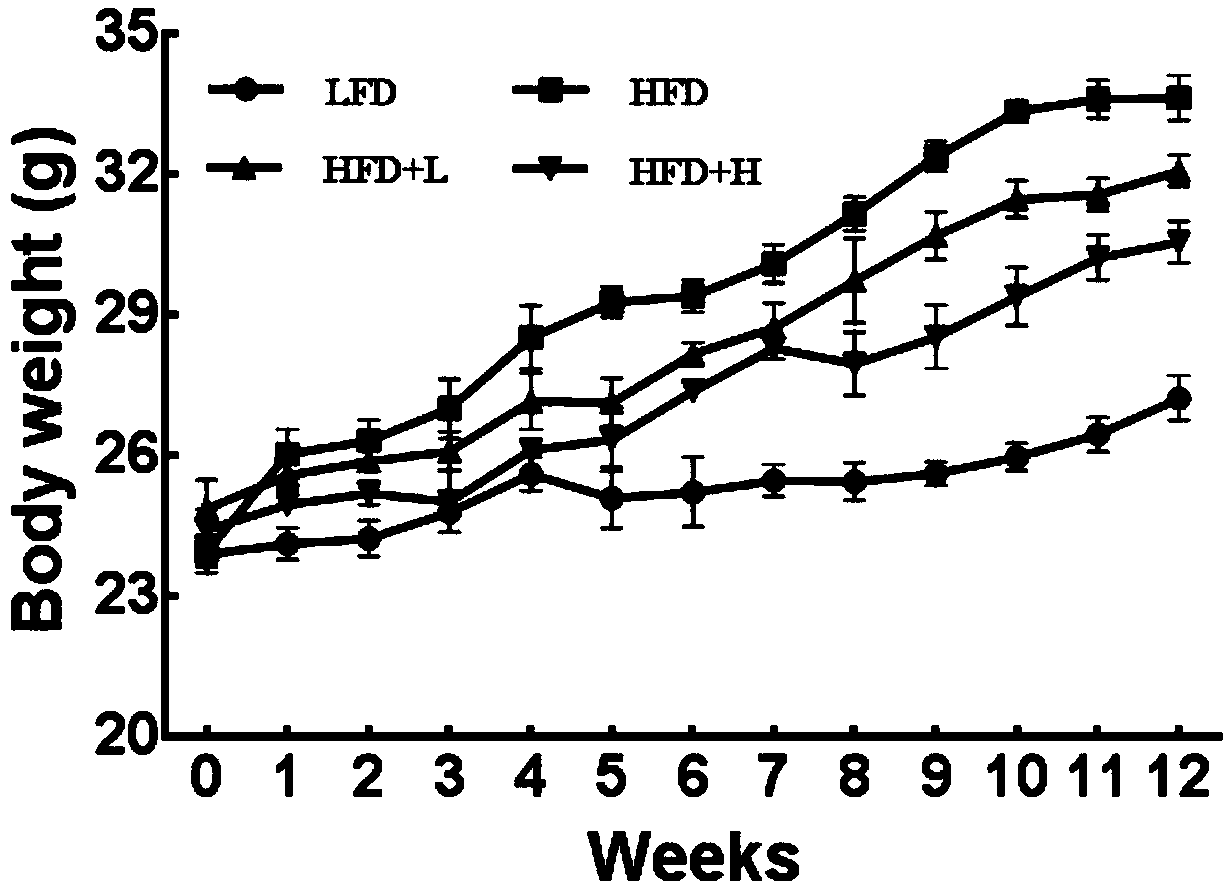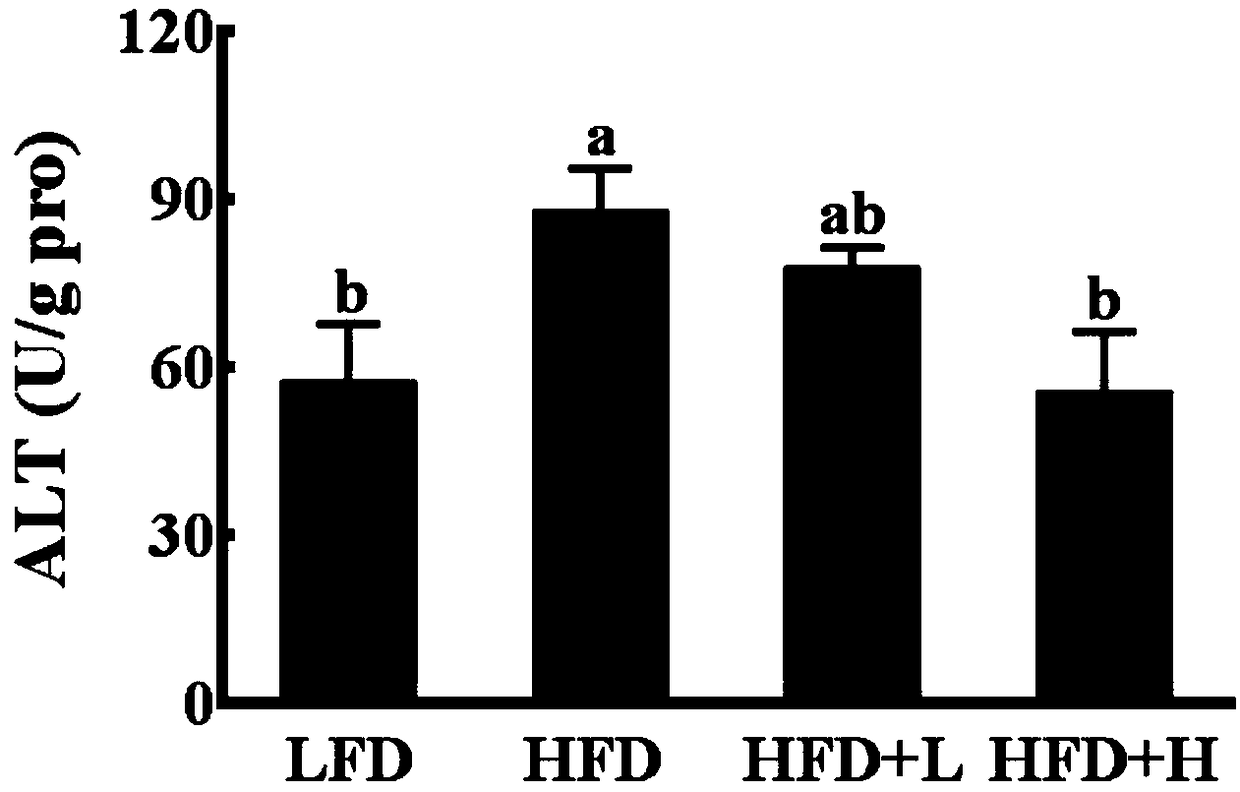Weight loss application of ethanol extract from bean taro leaves
A technology of ethanol extraction and bean taro, which is applied in the field of medicine, can solve the problems that the weight loss activity of bean taro leaf ethanol extract is rarely reported, and achieve the prevention of obesity and related chronic diseases, alleviating weight gain, and significant effects Effect
- Summary
- Abstract
- Description
- Claims
- Application Information
AI Technical Summary
Problems solved by technology
Method used
Image
Examples
Embodiment 1
[0047] Example 1. The weight-loss application of the ethanol extract of bean taro leaves, such as Figure 1-Figure 5 As shown, the ethanol extract of bean taro leaves has significant weight loss and lipid-lowering effects.
[0048] The specific preparation steps of the ethanol extract of taro leaves are as follows:
[0049] (1) According to the material-to-liquid ratio of 1g:8ml, the bean taro leaves are mixed with 85% ethanol containing 0.1mol / L hydrochloric acid, and then processed by a juicer to make pulp. After the obtained slurry was leached by ultrasonic (ultrasonic frequency of 40,000 Hz) at 45°C for 240 minutes, the extract was centrifuged at 4000 rpm for 30 minutes, and the extract was centrifuged to obtain the supernatant.
[0050] (2) Replace the bean taro leaves in step (1) with the filter residue obtained from step (1) centrifugation, repeat the extraction twice, combine the three filtrates, and transfer the resulting supernatant to the rotary evaporator (the process pa...
Embodiment 2
[0061] Example 2. The effect of ethanol extract of bean taro leaves on the fat, liver and other organ indexes of obese mice;
[0062] After 12 weeks of intragastric administration in Example 1, the mice were fasted for 24 hours and weighed. After blood was taken from the orbit, the mice were sacrificed by dislocation of the cervical spine. The fat around the kidney and epididymis was taken, and the heart, liver, spleen and kidney were quickly removed. , Brown fat and other tissues and record the weight. The specific data is shown in Table 1.
[0063] Table 1 The effect of the ethanol extract of bean and taro leaves on the organ index of mice
[0064]
[0065] According to Table 1, different doses of ethanol extract of bean and taro leaves can significantly reduce the pericyte and perrenal fat index in obese mice. Compared with the high-fat control group, the ethanol extract of bean and taro leaves has an effect on liver and brown fat. , Heart, kidney, spleen and pancreas index had n...
Embodiment 3
[0066] Example 3. The effect of ethanol extract of bean taro leaves on serum triglyceride, total cholesterol, alanine aminotransferase and aspartate aminotransferase content in obese mice;
[0067] After 12 weeks of intragastric administration in Example 1, the mice were fasted for 24 hours. After blood was taken from the orbit, the mice were sacrificed by cervical dislocation. The blood samples were centrifuged at 1500 revolutions for 15 minutes, and the serum was collected and preserved. Triester and total cholesterol content were determined, and the specific data are shown in Table 2.
[0068] Table 2 Effect of ethanol extract of bean and taro leaves on serum indexes in mice
[0069]
[0070] According to Table 2, both the high-dose group and the low-dose group can significantly reduce the serum triglyceride, cholesterol content, alanine aminotransferase and aspartate aminotransferase content in obese mice. The above results indicate that the ethanol extract of soybean and taro l...
PUM
 Login to View More
Login to View More Abstract
Description
Claims
Application Information
 Login to View More
Login to View More - R&D
- Intellectual Property
- Life Sciences
- Materials
- Tech Scout
- Unparalleled Data Quality
- Higher Quality Content
- 60% Fewer Hallucinations
Browse by: Latest US Patents, China's latest patents, Technical Efficacy Thesaurus, Application Domain, Technology Topic, Popular Technical Reports.
© 2025 PatSnap. All rights reserved.Legal|Privacy policy|Modern Slavery Act Transparency Statement|Sitemap|About US| Contact US: help@patsnap.com



